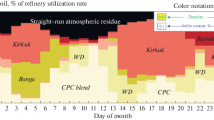Abstract
The efficiency of dewaxing of wide and narrow distillation raffinates using different mixed solvents: acetone and methyl–tert–butyl ether (MTBE), acetone and toluene, methyl ethyl ketone (MEK) and toluene, is compared. Decreasing the cutpoints from 100–140 to 50–70°C increases the filtration rate by 2 and more times and the yield of dewaxed lube oil by 2.5–5% as a function of the solvent used.
Similar content being viewed by others
REFERENCES
T. V. Voznesenskaya et al., Khim. Tekhnol. Topl. Masel, No. 7, 10-13 (1976).
I. O. Kolesnik et al., Oil Refining [in Russian], No. 8, TsNIITEneftekhim, Moscow (1989).
S. Sh. Abramovich and N. N. Trubenkova, Studies at Bashkir Scientific-Research Institute of Oil Refining [in Russian], Khimiya, Moscow (1971), pp. 15-17.
T. I. Sochevko et al., Neftepererab. Neftekhim., No. 7, 33-37 (2000).
Author information
Authors and Affiliations
Rights and permissions
About this article
Cite this article
Litszyun', V., Ol'kov, P.L., Aznabaev, S.T. et al. Increasing Raffinate Dewaxing Efficiency. Chemistry and Technology of Fuels and Oils 39, 166–169 (2003). https://doi.org/10.1023/A:1025429910348
Issue Date:
DOI: https://doi.org/10.1023/A:1025429910348




